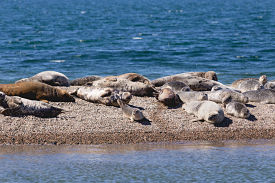Lloyd Center Goes On Seal Watching Expedition
By Lauren Zaknoun | Mar 24, 2016 | Dartmouth Week

Harbor and grey seals were seen lazing on a sand bar near Cuttyhunk Island on Saturday, March 19. Photo by: Lauren Zaknoun
While Massachusetts boasts a wealth of interesting wildlife many on a Lloyd Center sponsored cruise were surprised to know that Buzzards Bay is home to seals.
On Saturday, March 19, members of the Lloyd Center set off on a Cuttyhunk Cruise for a seal watch. Not only did they enjoy seal watching, they also explored Cuttyhunk Island,
which, during the winter, is inhabited by fewer than 20 people.
The Lloyd Center’s mission is “to instill a life-long respect and affection for nature in citizens of all ages through research, education and outreach,”
said Education Specialist Jasmine Smith-Gillen. “Observing animals first-hand, especially in their own natural habitat, is captivating,” she said. “Those seals were doing exactly what they
always do, every day they haul out on the sandbar to dry off and warm up. Watching an animal takes us outside of ourselves, makes us appreciate
how small we are in our little part in the world.”
Harbor and grey seals were seen lazing on a sandbar just off of Gull Island. The narrow strip of land was packed from one end to the other with
wintering seals, many of which perked up at the sight of the boat. Several curious seals bobbed about in the water, investigating the ship as is drifted toward the sandbar.
Lazing is an important part of a seal’s routine, allowing it to rest and replenish its energy to be able to avoid and escape from predators.
Smith-Gillen shared some facts about native seals. Seals are present year round in the area and it is not uncommon to see them. Gray and harbor
seals, the populations of which had plummeted in the 1970s when they were hunted, have increased dramatically since they were given protection under the Marine Mammal Protection Act. However, their increased number have also led them to attract predators like sharks. They can also be a nuisance to fishermen, who see seals as competition for fishing stock.
Once on Cuttyhunk, attendees went birdwatching and shelling on the island. Home to summering families during the warmer months, the island was all but deserted for the winter. A large group trekked with Smith-Gillen and Lloyd Center Research Associate Jamie Bogart to Lookout Hill, Cuttyhunk’s highest point.
According to Smith-Gillen, spending time outdoors provides a myriad of benefits. Not only to be people learn about their local ecosystem, but the exercise can improve brain activity and lower blood pressure.
After departing, the ship pulled up once again to the sandbar, observing the seals from a different angle, this time managing to drift a bit closer to them.
“Learning is a key pathway for students of all ages to gain a new appreciation for the natural world and its wildlife,” said Smith-Gillen. “My career in environmental education is focused on making a difference. I help to teach children and adults about the natural world, so that they will be motivated to take action.”

